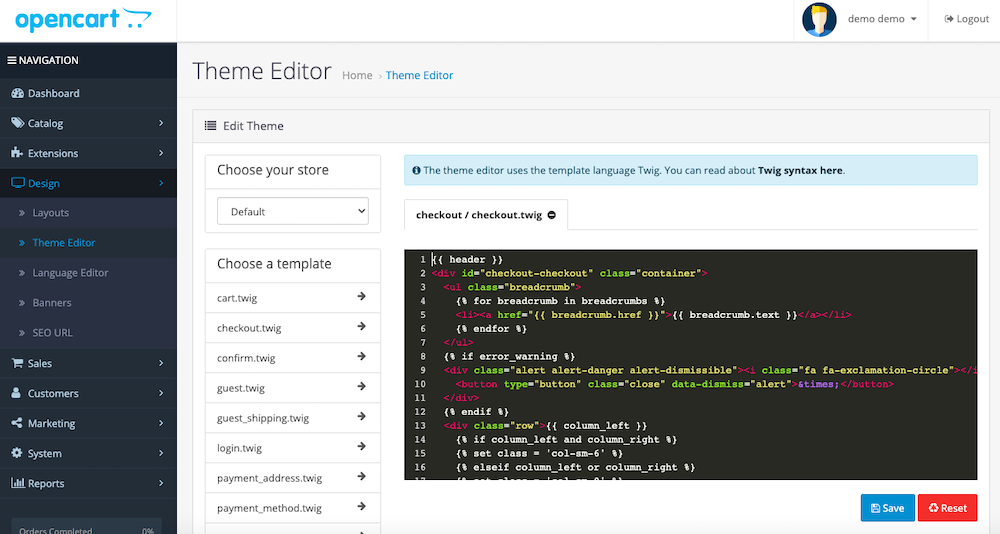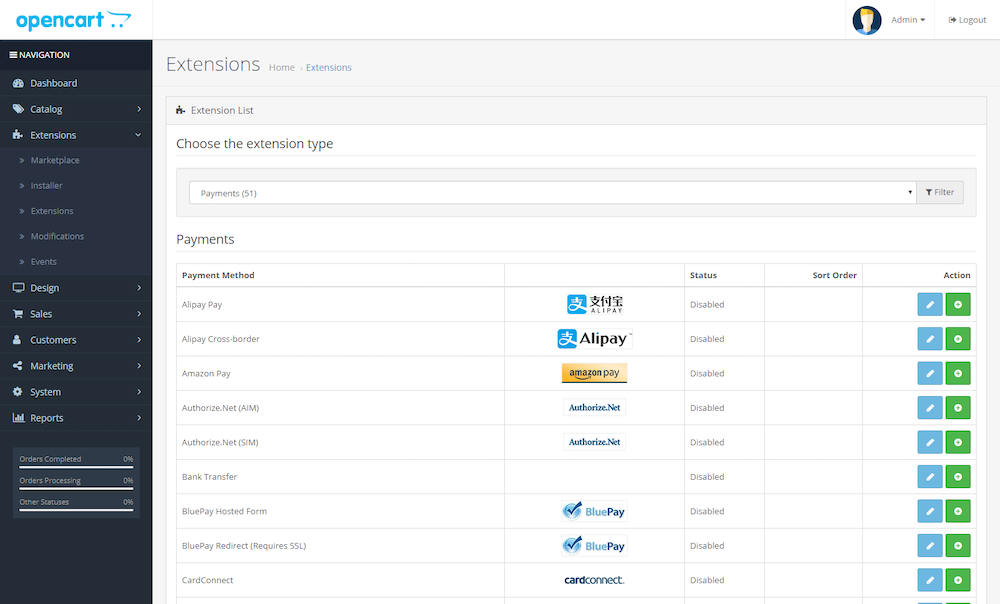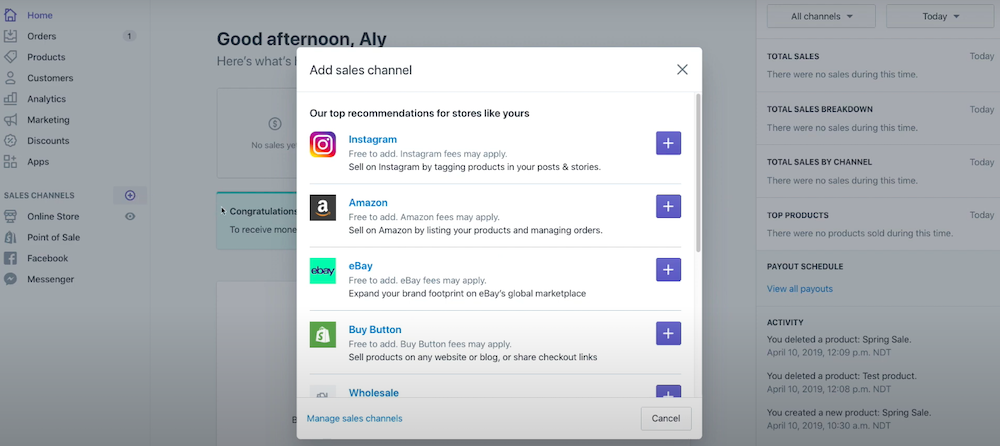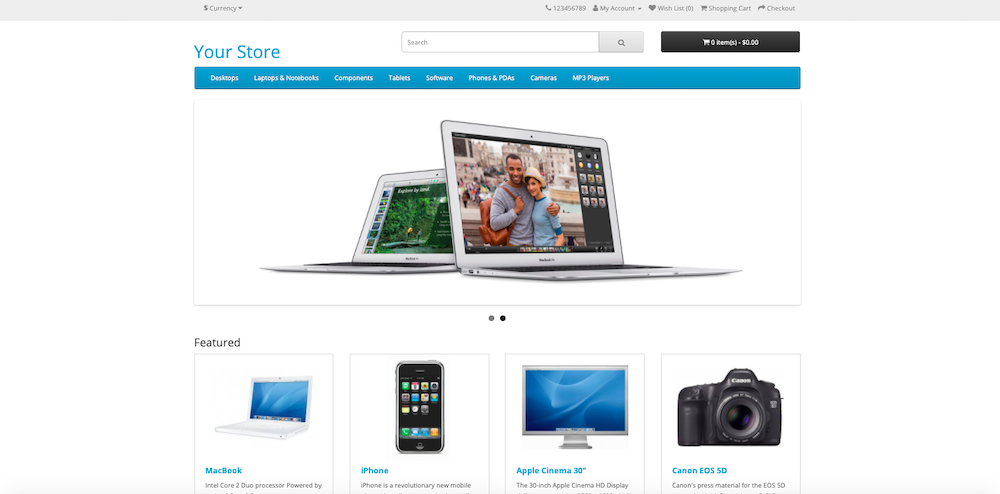The right ecommerce platform is essential to the way you run your online business. After all, this platform will allow you to set up your store, accept payments, manage your orders, and more.
As you explore the variety of ecommerce solutions that are available, you may find yourself looking into both OpenCart and Shopify. So, which of these two popular platforms is right for your ecommerce needs? We’re here to help you find out.
In this guide, we’ll compare OpenCart vs. Shopify in terms of pricing, features, and user reviews—so that you have everything you need to make an informed decision for your business.
OpenCart vs. Shopify Comparison Chart
| OpenCart | Shopify | |
|---|---|---|
Overview
|
Open-source ecommerce platform that can be downloaded for free and customized for your business
|
All-in-one, web-based ecommerce platform with subscription that gives you access to various features
|
Pricing
|
Free to download and use; must pay for separate web hosting, maintenance, and extensions
|
Ranges from $9 per month for Shopify Lite to $299 per month for Advanced Shopify
|
Plans
|
N/A
|
Three basic plans, as well as Shopify Lite and Shopify Plus
|
Top Features
|
– Highly customizable open-source platform
– Unlimited user access -Automatically integrated with over 30 top payment gateways – Sell in any currency with automatic rate updates – Much more accessible open-source solution compared to competitors |
– Easy to use drag-and-drop store builder
– Multi-channel sales integrations with Amazon, eBay, Instagram, etc. – Shopify Payments built-in – Blog, abandoned cart recovery, SSL certificate, and shipping discounts included with all plans |
Mobile App
|
Mobile-responsive but no dedicated mobile app to manage your store
|
Free Shopify ecommerce mobile app for iOS and Android, plus Shopify POS mobile app and Shopify Ping mobile app |
Integrations
|
Over 13,000 extensions available in the OpenCart Marketplace |
Over 1,000 apps available in the Shopify App Store
|
Customer Support
|
Forum-based support, as well as online documentation; personalized support can be purchased on a one-time or monthly basis |
24/7 customer support, plus variety of online self-support resources
|
Businesses that need customization capabilities, to manage multiple stores with one platform, or avoid monthly subscription fee; business owners with technical knowledge |
Newer businesses and ecommerce beginners; businesses looking to get selling online as quickly and easily as possible, as well as those looking for all-in-one web-based store management
|
OpenCart vs. Shopify: Pricing
As you might expect, since OpenCart and Shopify are both ecommerce platforms designed for the same purpose, the two solutions are inherently similar—providing the tools you need to set up and customize your online store, list products, accept payments and process orders, and market your business to customers.
However, when it comes to deciding between the two of them, it’s important to look at the areas in which they differ. Therefore, one of the biggest differences between OpenCart vs. Shopify is pricing.
Whereas OpenCart is an open-source solution, meaning it’s free to download, edit, and use to manage your online store, Shopify is a fully hosted platform. Unlike OpenCart, Shopify operates on a monthly subscription basis—you pay a monthly fee for your plan and have web-based access to their software with all of the plan features included out-of-the-box.
With this in mind, let’s break down the pricing of these two solutions in a little more detail:
OpenCart Pricing
Once again, OpenCart is completely free to download. As an open-source solution, OpenCart’s code is available for download on their website and can be completely edited and customized as you see fit.
It’s important to remember, however, that even though the OpenCart software itself is free, it’s not completely free to start your online store using this platform. There are a few costs that you’ll incur when using OpenCart:
- Web hosting: To launch your OpenCart store, you’ll have to pay for your own web hosting, the cost of which will vary based on the provider you use and size of your business. Generally, you can access web hosting for just a few dollars a month for smaller needs. In fact, OpenCart works with hosting provider A2Hosting to give you the ability to get started even quicker. Right now, A2Hosting offers their entry-level plan for just $2.99 per month.
- Accepting payments: As with any ecommerce platform, you’ll have to pay for payment processing in order to accept payments online. OpenCart includes 36 payment methods integrated in their software, as well as hundreds more in their marketplace. The cost, therefore, will vary based on the payment processing company you choose. Typically, you’ll pay 2.9% + $0.30 per transaction with most processors.
- Extensions: Although OpenCart includes impressive features from the start, you can expand your capabilities with extensions available in their marketplace. There are a number of free themes and apps in the marketplace; however, some will require a paid license. To accept payments with Stripe, for example, you need to install an extension—which requires a $59.99 yearly license fee.
- Customization and maintenance: You might not need a developer or web professional to help you customize and maintain your OpenCart site, but depending on your individual experience, it could be helpful. Although OpenCart is certainly easier to manage than some open-source solutions, like Magento, for example, you might get the most out of the platform by working with a web developer.
- Support: Similar to our last point, as an open-source solution, OpenCart does not include personalized customer support with their platform. They do, however, offer a paid premium support service. With this service, you can opt for one-time or monthly support—one-time help starts at $99 and monthly support costs $99 per month per site.
Ultimately, the free-to-download aspect of OpenCart is highly appealing to business owners on a budget. However, it’s important to remember that although OpenCart can be very affordable, it’s much more difficult to estimate your total costs at a quick glance. The costs you’ll pay for this platform on a monthly or annual basis will largely depend on the tools you need for your specific business.
Shopify Pricing
Although there is no free version of Shopify (other than the 14-day free trial), it’s much easier to evaluate the cost of using this online shopping cart software on a monthly or annual basis. As an all-in-one, fully hosted solution, Shopify is priced on a monthly subscription basis. The features you receive with Shopify vary based on the plan you choose.
Overall, Shopify offers a total of five plans—three core plans, Basic Shopify, Shopify, and Advanced Shopify—as well as Shopify Lite and Shopify Plus.
| Shopify Lite | Basic Shopify | Shopify | Shopify Advanced | Shopify Plus | |
|---|---|---|---|---|---|
Cost
|
$9 per month
|
$29 per month
|
$79 per month
|
$299 per month
|
Quote-based
|
What’s Included
|
– Add products to any website or blog and accept credit card payments
|
– Online store and blog
– Unlimited products – Two staff accounts – 24/7 support – Multiple sales channels – Up to four locations – Manual order creation, discount codes, free SSL certificate, abandoned cart recovery – Shipping discounts and shipping label printing |
– All the features of Basic Shopify
– Five staff accounts – Up to five locations – Professional reports – USPS Priority Mail Cubic pricing |
– All the features of Basic Shopify and Shopify
– Up to 15 staff accounts – Up to eight locations – Advanced report builder – Third-party calculated shipping rates |
– Enterprise features beyond Shopify Advanced
|
Unlike OpenCart, web hosting and support are included within the Shopify plans. In addition, although you could pay a professional for customization and maintenance assistance, Shopify is designed for all types of business owners—especially beginners. With a drag-and-drop builder, it should be much easier to set up your store with Shopify.
This being said, however, you will incur credit card processing fees with Shopify as well. If you use Shopify’s own processing service, Shopify Payments, your rates will be as follows:
- Basic Shopify: 2.9% + $0.30 per transaction for online payments; 2.7% per transaction for in-person payments
- Shopify: 2.6% + $0.30 per transaction for online payments; 2.5% per transaction for in-person payments
- Advanced Shopify: 2.4% + $0.30 per transaction for online payments; 2.4% per transaction for in-person payments
Of course, Shopify also gives you the ability to use third-party payment processors, who will charge their own rates. If you use one of these services, however, you’ll incur a transaction fee from Shopify on top of the processor rates—either 2%, 1%, or 0.5% depending on your plan.
Moreover, like OpenCart, Shopify allows you to download themes or apps from their app store. Although some are free, others will require a subscription or license fee.
All in all, Shopify is always going to be more expensive than OpenCart on the surface. The platform that’s most affordable, however, will really depend on what your business needs. For example, you could opt for Basic Shopify and pay $29 per month, or choose OpenCart and only pay $10 per month for web hosting—in this case, OpenCart is much more affordable.
However, if you need to buy extensions, themes, or support to use OpenCart, your costs could quickly grow to mirror those of Shopify.
Store Setup
As we discussed briefly in regards to pricing, Shopify is designed to be a much more approachable way to build and launch an ecommerce website. With Shopify, you can choose from a variety of free and paid themes, customize your store using their drag-and-drop builder, and manage everything from the web.
In addition, within your basic store setup, Shopify includes web hosting, as well as gives you access to a built-in blog, instant platform updates, and multiple sales channels (like Amazon, Google Shopping, Instagram, etc.).

This example shows the theme editor within Shopify’s platform. Image source: Shopify
With OpenCart, on the other hand, you have to download the software and install it locally onto your computer. Then, you can launch OpenCart, make your edits and customizations, and work with a hosting provider to get everything set up. Although Shopify does have some HTML and CSS customization capabilities, OpenCart is much more technical.
However, OpenCart also offers a variety of themes to choose from, as well as gives you multi-store capabilities (which Shopify does not offer) and the ability to set up your own backups.

Here, you can see an example of the theme editor within OpenCart. Image source: OpenCart
Ultimately, in terms of setup, OpenCart is a much more involved and hands-on process. Shopify, on the other hand, is more user-friendly, allowing you to get set up and running as quickly as possible.
Store Management
In terms of tools to manage your store, it’s worth noting that both OpenCart and Shopify allow you to list an unlimited number of products—which is not something that all ecommerce platforms offer.
Additionally, OpenCart uniquely includes a built-in affiliate system, as well as capabilities for discounts, coupons, and specials. Moreover, OpenCart also offers integrated product reviews and ratings modules, a built-in rewards points system, and a variety of shipping methods from across the world.
In comparison, Shopify offers many of the same or similar features, as well as a few tools that are not included in the basic version of OpenCart. Shopify includes more intuitive tools for managing inventory, as well as dropshipping integrations, fulfillment center connections, email templates, and abandoned cart recovery.
Moreover, Shopify is automatically integrated with Shopify POS, allowing you to sell in-person as well as online.
With all of this in mind, Shopify and OpenCart are perhaps the most similar in terms of their core store management features—especially since both give you the ability to easily increase your functionality with apps and extensions (as we’ll discuss below).
This being said, although they have their slight differences, there’s no doubt that Shopify makes it a little easier to manage processes across the platform, especially when it comes to multi-channel selling and generating sales leads.
Accepting Payments
As we mentioned in our discussion of pricing, the biggest difference between OpenCart vs. Shopify in terms of payments is that Shopify offers their own internal processing service, Shopify Payments.
Although Shopify Payments isn’t available in all countries, it does make it easier for those who have access to it to start accepting and processing payments right away. Plus, if you opt for a higher-level plan, you can access lower processing rates than you typically see with most online processors.
Of course, Shopify does offer a variety of integrations with payment gateway providers, but they also charge that additional transaction fee to use a third-party processor.
With OpenCart, on the other hand, you have much greater flexibility in terms of payment processing. You can use any of the 36 payment methods that are automatically integrated with OpenCart or download any of the available extensions in the marketplace.

Payment options available within OpenCart. Image source: OpenCart
Unlike Shopify, OpenCart doesn’t charge any transaction fees to accept payments; you’ll simply pay the fees the processor charges.
Along these lines, it’s also worth noting that OpenCart is much more accessible for multi-currency stores, as you can sell in any currency with automatic rate updates and the ability to set up different taxes. With Shopify, multi-currency can only be used with Shopify Payments.
Customers and Marketing
Once again, perhaps some of the most notable marketing tools that OpenCart offers is their built-in affiliate system, as well as rewards programs, discounts, and coupons. They also provide the ability to create customer groups, send basic email newsletters, and add and track marketing campaigns.
In contrast, Shopify again stands out in terms of their multi-channel capabilities. Shopify not only allows you to offer discounts, gift cards, and other perks, but also gives you the ability to sell on Facebook, integrate automatically with social media channels, as well as set up customer profiles, accounts, and groups.

Different sales channels available with Shopify. Image source: Shopify
Additionally, Shopify’s built-in blog and SEO tools allow you to engage in content marketing. Even though OpenCart also offers a variety of ecommerce tools, as we mentioned above, they do not include a built-in blog.
Overall, although Shopify and OpenCart each provide the essential tools to manage your customers and marketing efforts, Shopify is a little more intuitive across their platform.
Analytics and Reporting
In terms of analytics and performance monitoring, OpenCart includes a solid variety of reports across sales, product, customers, and marketing. From the admin interface, you can get a glance of your store’s performance and then dive in deeper for more details.
With Shopify, you have access to a similar, action-oriented dashboard which displays your sales, orders, and traffic. In addition, you also can create product, traffic, and referral reports, and export them into a spreadsheet tool. Perhaps most notable, however, is that Shopify includes an automatic integration with Google Analytics, which allows you to track sales, visits, and referrals through this widely used web analytics tool.
To this point, it is important to note that Shopify does limit some of your reporting capabilities based on plan. To generate professional reports, you’ll need at least the Shopify plan, and for the advanced report builder, you’ll need the Advanced Shopify plan.
Mobile
Shopify and OpenCart are very different in terms of their mobile capabilities. Although both platforms are mobile-responsive and designed to function efficiently across desktop, mobile, and tablet devices, Shopify offers not one, but three different mobile app tools that you can use for your business.
First, Shopify offers their basic mobile app, which allows you to fulfill orders, manage inventory, email or call customers, and track trends. This app also syncs all of your data—inventory, orders, products, customers—from your online store.
On top of the Shopify mobile app, you can also take advantage of the Shopify POS app in order to process orders and accept payments in-person, as well as the Shopify Ping app, in order to manage messages from your customers.
In contrast, OpenCart does not offer any downloadable mobile commerce apps to manage your account.
Integrations
We’ve briefly mentioned the integration options Shopify and OpenCart provide, but when it comes down to it, both of these platforms have impressive app and extension offerings. With more than 13,000 extensions included in the OpenCart marketplace, you have a quick and easy way to add features to your solution, without having to develop new modules or tools yourself.
With Shopify, you have access to over 1,000 third-party integrations across a wide variety of categories.
However, a valid criticism of both of these solutions is their reliance on integrations. Although these integrations give you the ability to expand your store’s functionality, many users feel that these add-ons quickly become expensive, as well as make your ecommerce website more difficult to manage.
Customer Support
Finally, in terms of customer support, Shopify provides 24/7 personalized support through their platform, whereas OpenCart (as an open-source solution) requires that you pay for an additional service to access this kind of support.
In addition, Shopify includes a wide range of self-service tools, such as their Help Center, forums, video tutorials, API documentation, and more.
Similarly, OpenCart offers self-service support through their extensive documentation and community forum. If you do want to pay for customer support, you can opt for one-time or monthly service.
Although this support isn’t included like Shopify, it is worth noting that you do have the option to reach OpenCart experts to assist you with your issues. Comparatively, not all open-source platforms offer this type of service.
OpenCart vs. Shopify: User Reviews
With all of this information in mind, it can be helpful to look at what users have to say about Shopify and OpenCart.
Overall, Shopify and OpenCart are pretty consistently rated across the internet, with both platforms receiving an average of four stars or higher on most review sites. Along these lines, you will see that Shopify tends to rate slightly higher, with 4.5 stars on Capterra compared to OpenCart’s 4.3 stars and 4.3 stars on G2 Crowd compared to OpenCart’s 4.2 stars.
To this point, however, it is worth noting that Shopify generally has more reviews written online than OpenCart.
This being said, let’s break down some of the most common points you see discussed in OpenCart and Shopify user reviews.
OpenCart Reviews
In terms of the benefits of OpenCart, user reviews tend to focus on:
- Free to download and use
- Variety of free and paid extensions available
- Learning curve is not as large compared to other open-source platforms (like PrestaShop or Magento)
- Great customization capabilities; can control all aspects
On the other hand, in terms of criticism, users frequently mention:
- Without extensions, software is pretty basic (especially compared to other open-source platforms); extensions can get expensive
- By default, it creates copies of pages, which hurts ecommerce SEO
- Has a learning curve to get started; user interface could be improved
- Could have better community support
- Updates can be time-consuming and difficult

Example of a store built with the basic OpenCart theme. Image source: OpenCart
Shopify Reviews
Comparatively, with Shopify, users reviews often highlight:
- General ease of use—from setup to store management to order fulfillment—especially for beginners
- Very easy to launch an online store quickly
- Intuitive interface, range of customization capabilities, especially with apps in app store
- Everything in one place makes it easier to run and streamline your operations
In terms of critiques of Shopify, users tend to focus on:
- Expensive in comparison to Shopify alternatives (and for new businesses on a budget); some of the best features require the higher-level plans
- Free templates are limited, especially in terms of customization
- Can be buggy, especially if you have a variety of app integrations
- Shopify Payments not available in all countries; have to pay additional transaction fees for using a third-party processor

Example of store built with the basic Shopify theme. Image source: Shopify
OpenCart vs. Shopify: Pros and Cons
At this point, you likely have a good sense of the OpenCart vs. Shopify comparison and hopefully, which platform might be a better choice for your business.
To help you decide, however, you can compare the pros and cons of both platforms using our summary below:
The Bottom Line
At the end of the day, there’s no doubt that both Shopify and OpenCart are highly functional ecommerce solutions and either platform has the potential to serve your business well.
When it comes down to it, however, it seems that Shopify is better-suited for newer businesses, as well as those that are looking to get their online store up and running as quickly and easily as possible and manage everything seamlessly in one place.
OpenCart, on the other hand, seems better-suited for businesses that would prefer a little more flexibility and customization with their ecommerce website builder, as well as those that are looking to avoid paying a monthly subscription fee.
This being said, only you can decide which platform is best suited for your needs. To this point, if you need additional information to make your final OpenCart vs. Shopify decision, we’d recommend trying out each platform for yourself.
Shopify offers a 14-day free trial and OpenCart can be downloaded for free. OpenCart also offers a storefront and admin demo of the software on their website.

Randa Kriss
Randa Kriss is a senior staff writer at Fundera.
At Fundera, Randa specializes in reviewing small business products, software, and services. Randa has written hundreds of reviews across a wide swath of business topics including ecommerce, merchant services, accounting, credit cards, bank accounts, loan products, and payroll and human resources solutions.

